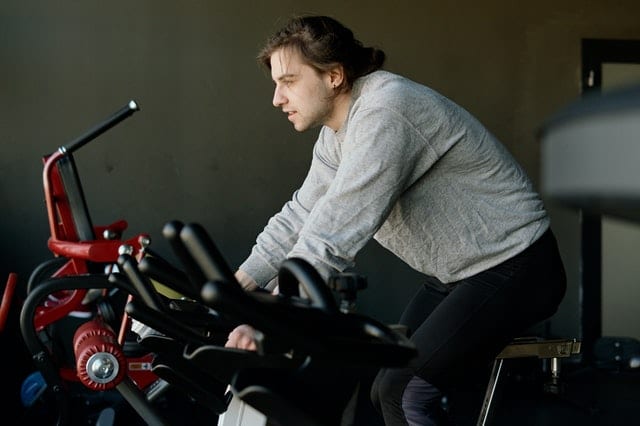If there is one piece of equipment found in most gyms worldwide, it is a stationary bike. Exercising on a stationary bike is a good idea if you are embarking on a weight loss journey, especially for newbies. It’s low impact, and is suitable for all ages. This article looks at the research behind stationary bikes and why you should get one.
Why Get A Stationary Bike?
Get a bike because it helps you shed some fat before you start a more strenuous exercise routine; this will cut back the physical strain on your heart and give you a head start that is gentle, with consistent results.
There are all kinds of stationary bikes available in the market. For example, recumbent bikes, spin bikes, smart-tech and clean-energy generating bikes. The high-tech ones can be connected via Wi-Fi and Bluetooth to online exercise platforms.Yet, they all provide the same effects with a bit of functional difference. The bottom line is that you are moving your calf muscles. The calf muscles are called the second or peripheral heart as they pump blood from the lower extremities up against gravity to the heart. So when you ride a stationary bike, you are building a physical endurance that can help you upgrade your fitness routine in the long run.
Going to the gym may be a lifeline for gym enthusiasts but for beginners, picking up a routine is the most challenging part of the game. It is best to invest in a good piece of stationary bike to keep at home; you can ride the bike at your convenience, which helps you better adopt a timetable and stick to it.
Reasons Why You Should Invest In A Stationary Bike:
- It improves cardio fitness
Cycling is a cardio exercise that improves heart and lung function. Yet, it is smooth enough to be easy on one’s joints. By strengthening the calf muscles, cycling a stationary bike improves circulation. When organs have a better blood supply, they function at their best.
Cycling improves the resting pulse rate of the heart while simultaneously cutting back the total fat content of the body. It benefits the heart by reducing the risk for stroke, heart attack and blood pressure. A Danish study conducted over 14 years involving 30,000 people aged 20 to 93 years found that regular cycling reduces heart disease risk.
Cycling on an indoor stationary bike is also an aerobic activity. Since the heart, lungs and blood vessels all get involved in the workout, it builds physical endurance. By sweating and breathing deep, overall fitness levels rev up.
- It helps weight loss
Cycling can help burn up to 600 calories per hour, depending upon the intensity level. Having a stationary bike at home is a good opportunity for weight loss.
According to Harvard University, moderate speed cycling at 12 to 13.9 miles per hour burns 298 calories in half an hour for a 155-pound person. This calorie loss increases to 372 when cycling speed is increased to14 to 15.9 miles per hour for the person with the same weight.
Harvard University suggests that the number of calories burned riding a stationary bicycle at a moderate pace is dependent on the weight of a person. The moderate pace is going at 12 to 13.9 miles per hour. This speed on a stationary bike will cause a calorie burn of 210 per half an hour for a person of 120 pounds weight. While for a person who weighs 155 pounds, the calorie lost is 260 when cycling at a moderate pace for half an hour.
- It’s low-impact
Cycling on a stationary bike is a low-impact exercise that does not strain one’s joints. This can be beneficial for people who cannot take a brisk walk or venture into HIIT type classes but are still looking for weight loss.
As cycling helps build the calf muscles with smooth movements, it strengthens bones and joints without any added burden. Because your feet remain on the pedals while cycling a stationary bike (unlike bikes that move), it causes less impact on the knees, ankles and hip joints.
- It’s safe to ride
Regular cycling is tagged with all kinds of road risks. Maneuvering through bends and around corners can be challenging, and requires taking other people’s safety into account. Having a stationary bike at home removes all those risks; You can continue with your routine even when the weather is not friendly or while you listen to music or read a book. This type of support helps to reduce boredom!
- It’s simple to use
Cycling is fun for everyone. A low-impact exercise for adults and children, cycling is an inexpensive way to have a good time and improve health. For kids, it is an excellent activity because childhood obesity is becoming an increasing global health concern. Cycling does not require high levels of skills or experience. There are no risks involved such as falls or fracture injuries, etc. Once you learn how to pedal, you will retain the ability to forever ride a bike.
- It caters to variety
You can be creative with your exercise schedule by upgrading the intensity with a stationary bike at home. Doing high-intensity cycling at intervals that cater to a cardio type pattern can also contribute to a significant number of calorie loss in half an hour. Start with a five minute warm-up. Do reps of one minute speed and two minutes of recovery time. The speed levels should be 7 to 9. Keep this going on in a loop.
- It’s an affordable solution
Keeping a stationary bike at home is an economical solution. Instead of paying hefty subscriptions to gym memberships or buying heavy gym equipment, a stationary indoor bike caters to a one-stop solution to your exercise problems. It only requires a one time investment! Some that have really piqued our interest range in capability & even price – Peloton, TechnoGym, Sunny Health & Fitness Bike and YOSUDA Indoor Cycling Bike.
Keeping a stationary bike at home is an easy and convenient way to keep fit, healthy and moving. With no roadside risks involved, a stationary bike is a fun solution for people of all ages.
References
1. https://www.ncbi.nlm.nih.gov/pmc/articles/PMC6722762/








